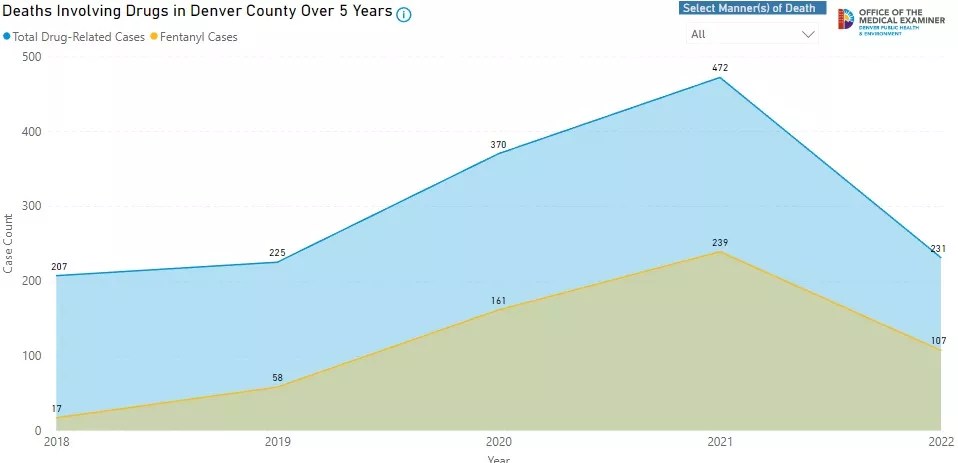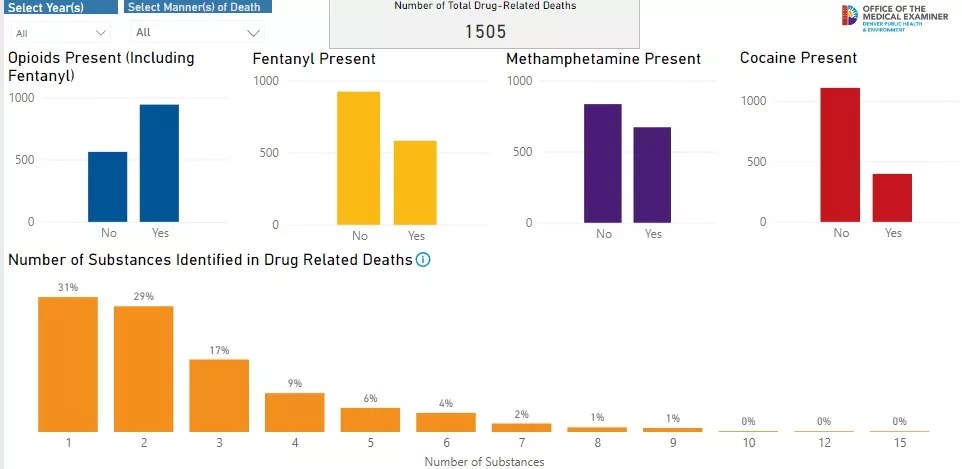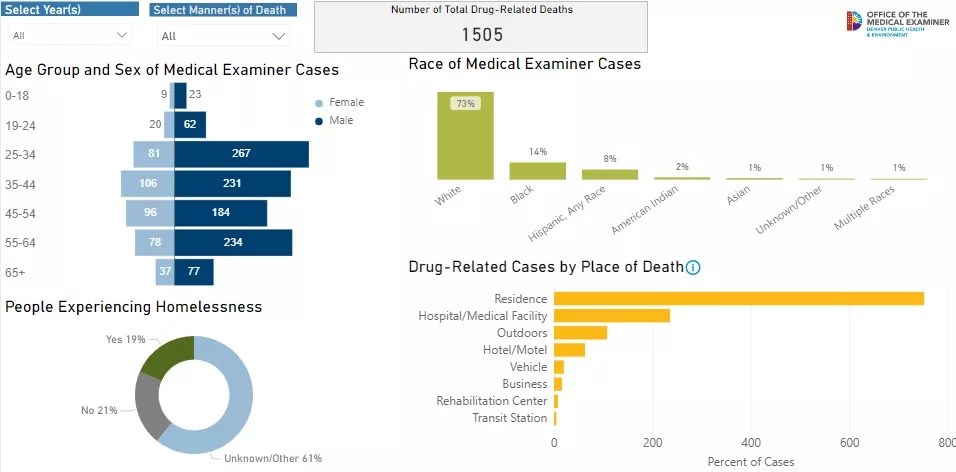
Family photo via New York Post

Audio By Carbonatix
The Denver Fentanyl Action Summit will resume today, September 13, at the Grand Hyatt Denver, where officials from the Denver Department of Public Health and Environment and other city agencies along with more than 200 public-health experts from across the region will brainstorm ways to lower the death toll related to the synthetic opioid.
The sessions aren’t open to the public, but a gusher of new information about drug fatalities in the Mile High City is now available through the Denver Office of the Medical Examiner. The agency recently launched a series of online dashboards that provide the latest statistics on a variety of subjects, including homicides, traffic casualties, deaths among people experiencing homelessness and COVID-19. The figures pertaining to overdoses are especially timely, since they reveal that the crisis, which prompted passage by the Colorado Legislature of the 2022 Fentanyl Accountability and Prevention act, is far more complicated than most people realize.
In short, fentanyl has made Denver’s drug overdose situation worse, but the problems that predated its introduction to the area definitely haven’t disappeared.
The Denver medical examiner’s overdose-fatalities dashboard is updated through September 9, but accompanying information acknowledges that stats are typically delayed several weeks and often more, “due to pending cases.” As a result, figures going back to at least early June of this year are incomplete, yet the numbers currently accessible reveal the width and breadth of fentanyl’s impact in Denver over the past five years.
The graphic below shows deaths from drugs in Denver County going back to 2018. The blue area pertains to all drug-related cases, while the tan section is specific to fentanyl.

Here’s the juxtaposition of total drug-related fatalities in Denver and deaths involving fentanyl:
2018
207 total cases
17 fentanyl cases2019
225 total cases
58 fentanyl cases2020
370 total cases
161 fentanyl cases2021
472 total cases
239 fentanyl cases2022 through September 9
231 total cases
107 fentanyl cases
The monthly numbers for drug fatalities in Denver are even more telling: The per-month totals in 2021 were roughly double those in 2018 owing to fentanyl – and that’s remained true for the first five months or so of 2022, when the statistics are closer to complete. Continue to see the specifics:
2018
January: 18 overdoses total; 2 fentanyl-related overdoses
February: 15 overdoses total; 0 fentanyl-related overdoses
March: 23 overdoses total; 2 fentanyl-related overdoses
April: 11 overdoses total; 0 fentanyl-related overdoses
May: 20 overdoses total; 1 fentanyl-related overdose
June: 11 overdoses total; 0 fentanyl-related overdoses
July: 16 overdoses total; 0 fentanyl-related overdoses
August: 13 overdoses total; 1 fentanyl-related overdose
September: 16 overdoses total; 3 fentanyl-related overdoses
October: 23 overdoses total; 2 fentanyl-related overdoses
November: 20 overdoses total; 3 fentanyl-related overdoses
December: 21 overdoses total; 3 fentanyl-related overdoses2019
January: 17 overdoses total; 2 fentanyl-related overdoses
February: 17 overdoses total; 1 fentanyl-related overdoses
March: 17 overdoses total; 3 fentanyl-related overdoses
April: 17 overdoses total; 2 fentanyl-related overdoses
May: 15 overdoses total; 4 fentanyl-related overdoses
June: 18 overdoses total; 4 fentanyl-related overdoses
July: 16 overdoses total; 6 fentanyl-related overdoses
August: 21 overdoses total; 8 fentanyl-related overdoses
September: 21 overdoses total; 5 fentanyl-related overdoses
October: 21 overdoses total; 6 fentanyl-related overdoses
November: 20 overdoses total; 7 fentanyl-related overdoses
December: 25 overdoses total; 10 fentanyl-related overdoses2020
January: 27 overdoses total; 8 fentanyl-related overdoses
February: 25 overdoses total; 9 fentanyl-related overdoses
March: 25 overdoses total; 3 fentanyl-related overdoses
April: 40 overdoses total; 18 fentanyl-related overdoses
May: 27 overdoses total; 15 fentanyl-related overdoses
June: 33 overdoses total; 11 fentanyl-related overdoses
July: 37 overdoses total; 19 fentanyl-related overdoses
August: 33 overdoses total; 18 fentanyl-related overdoses
September: 32 overdose total; 18 fentanyl-related overdoses
October: 30 overdoses total; 9 fentanyl-related overdoses
November: 23 overdoses total; 14 fentanyl-related overdoses
December: 38 overdoses total; 19 fentanyl-related overdoses2021
January: 44 overdoses total; 21 fentanyl-related overdoses
February: 25 overdoses total; 11 fentanyl-related overdoses
March: 31 overdoses total; 12 fentanyl-related overdoses
April: 36 overdoses total; 17 fentanyl-related overdoses
May: 40 overdoses total; 19 fentanyl-related overdoses
June: 55 overdoses total; 30 fentanyl-related overdoses
July: 42 overdoses total; 19 fentanyl-related overdoses
August: 47 overdoses total; 31 fentanyl-related overdoses
September: 52 overdoses total; 28 fentanyl-related overdoses
October: 34 overdoses total; 14 fentanyl-related overdoses
November: 28 overdoses total; 16 fentanyl-related overdoses
December: 38 overdoses total; 21 fentanyl-related overdoses2022 through September 9
January: 39 overdoses total; 20 fentanyl-related overdoses
February: 37 overdoses total; 15 fentanyl-related overdoses
March: 37 overdoses total; 20 fentanyl-related overdoses
April: 35 overdoses total; 15 fentanyl-related overdoses
May: 44 overdoses total; 17 fentanyl-related overdoses
June: 22 overdoses total; 12 fentanyl-related overdoses
July: 12 overdoses total; 6 fentanyl-related overdoses
August: 4 overdoses total; 2 fentanyl-related overdoses
September: 1 overdose total; 0 fentanyl-related overdoses
October: N/A
November: N/A
December: N/A

Contextualizing the information is made more difficult by the fact that fentanyl is frequently mixed with other narcotics, sometimes without the user’s knowledge; that’s one reason that the section of the Fentanyl Prevention and Accountability act that potentially makes having a small amount of the drug a felony even when individuals don’t realize it’s in their possession was so controversial.
The dashboard’s focus on drug classification and polysubstances, as seen in the graphic above, illustrates the issue. Of 1,505 total overdose deaths analyzed by the Denver medical examiner, opioids were present in 942, and fentanyl specifically in 582. But methamphetamines were found in 671 cases and cocaine in 397.
Moreover, only 31.07 percent of fatal overdoses were caused by a single drug. Two drugs were present in nearly as many drug deaths – 28.97 percent – while three were found in 16.69 percent, four in 8.96 percent, and so on. Indeed, nearly 1 percent of those who died from overdoses had nine drugs in their system when they died.

The dashboard’s revelations about the age and race show that the overwhelming majority of victims are white males. The details for 2021 and 2022 to date:
2021 fatal overdose deaths
127 female
345 male
White: 80.51 percent
Black: 13.56 percent
American Indian: 2.97 percent
Hispanic: 1.69 percent
Asian: 0.85 percent
Unknown/other: 0.42 percent2022 overdose deaths through September 9
56 female
175 male
White: 79.65 percent
Black: 12.55 percent
American Indian: 3.46 percent
Hispanic: 2.16 percent
Multiple races: 1.73 percent
Unknown/other: 0.43 percent
Many drug overdose victims were experiencing homelessness when they died – 91 in 2021 and fifty in 2022 so far. And no age range is immune. Although the August death of thirteen-year-old Jose Hernandez from a suspected fentanyl overdose made national headlines, at least twelve Denver residents under the age of nineteen died of a drug overdose in 2021, and six overdose deaths have been confirmed in this category during 2022. The odds that fentanyl was a factor in at least some of these cases is extremely high.
These are the fatal-overdose age breakdowns for 2021 and 2022:
2021
0-18: 2.54 percent
19-24: 5.51 percent
25-34: 23.73 percent
35-44: 22.03 percent
45-54: 16.45 percent
55-64: 18.64 percent
65+: 6.99 percent2022
0-18: 2.6 percent
19-24: 3.46 percent
25-34: 18.18 percent
35-44: 24.24 percent
45-54: 16.45 percent
55-64: 25.54 percent
65+: 9.52 percent
Find more information about the Denver Department of Public Health and Environment’s efforts to stem drug overdoses in the Road to Wellness, a behavioral health framework designed to get people into treatment, and the Empower Denver Strategic Plan. The department also touts the roving support team associated with the mobile Wellness Winnie and services available through the Behavioral Health Solutions Center. In addition, the DDPHE makes harm-reduction tools such as fentanyl test strips and naloxone, which can reverse overdoses, available at no cost. Click for more details.